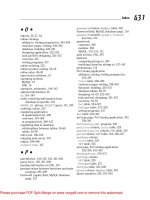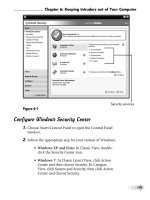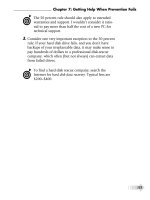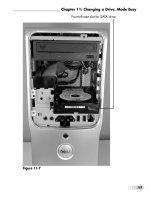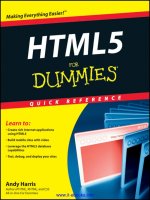Blockchain for dummies by tiana laurence
Bạn đang xem bản rút gọn của tài liệu. Xem và tải ngay bản đầy đủ của tài liệu tại đây (2.97 MB, 272 trang )
Blockchain For Dummies®
Published by: John Wiley & Sons, Inc., 111 River Street, Hoboken, NJ 07030-5774,
www.wiley.com
Copyright © 2017 by John Wiley & Sons, Inc., Hoboken, New Jersey
Published simultaneously in Canada
No part of this publication may be reproduced, stored in a retrieval system or transmitted in any
form or by any means, electronic, mechanical, photocopying, recording, scanning or otherwise,
except as permitted under Sections 107 or 108 of the 1976 United States Copyright Act, without
the prior written permission of the Publisher. Requests to the Publisher for permission should be
addressed to the Permissions Department, John Wiley & Sons, Inc., 111 River Street, Hoboken, NJ
07030, (201) 748-6011, fax (201) 748-6008, or online at
.
Trademarks: Wiley, For Dummies, the Dummies Man logo, Dummies.com, Making Everything
Easier, and related trade dress are trademarks or registered trademarks of John Wiley & Sons, Inc.
and may not be used without written permission. All other trademarks are the property of their
respective owners. John Wiley & Sons, Inc. is not associated with any product or vendor
mentioned in this book.
LIMIT OF LIABILITY/DISCLAIMER OF WARRANTY: THE PUBLISHER AND THE
AUTHOR MAKE NO REPRESENTATIONS OR WARRANTIES WITH RESPECT TO THE
ACCURACY OR COMPLETENESS OF THE CONTENTS OF THIS WORK AND
SPECIFICALLY DISCLAIM ALL WARRANTIES, INCLUDING WITHOUT LIMITATION
WARRANTIES OF FITNESS FOR A PARTICULAR PURPOSE. NO WARRANTY MAY BE
CREATED OR EXTENDED BY SALES OR PROMOTIONAL MATERIALS. THE ADVICE
AND STRATEGIES CONTAINED HEREIN MAY NOT BE SUITABLE FOR EVERY
SITUATION. THIS WORK IS SOLD WITH THE UNDERSTANDING THAT THE PUBLISHER
IS NOT ENGAGED IN RENDERING LEGAL, ACCOUNTING, OR OTHER PROFESSIONAL
SERVICES. IF PROFESSIONAL ASSISTANCE IS REQUIRED, THE SERVICES OF A
COMPETENT PROFESSIONAL PERSON SHOULD BE SOUGHT. NEITHER THE
PUBLISHER NOR THE AUTHOR SHALL BE LIABLE FOR DAMAGES ARISING
HEREFROM. THE FACT THAT AN ORGANIZATION OR WEBSITE IS REFERRED TO IN
THIS WORK AS A CITATION AND/OR A POTENTIAL SOURCE OF FURTHER
INFORMATION DOES NOT MEAN THAT THE AUTHOR OR THE PUBLISHER ENDORSES
THE INFORMATION THE ORGANIZATION OR WEBSITE MAY PROVIDE OR
RECOMMENDATIONS IT MAY MAKE. FURTHER, READERS SHOULD BE AWARE THAT
INTERNET WEBSITES LISTED IN THIS WORK MAY HAVE CHANGED OR
DISAPPEARED BETWEEN WHEN THIS WORK WAS WRITTEN AND WHEN IT IS READ.
For general information on our other products and services, please contact our Customer Care
Department within the U.S. at 877-762-2974, outside the U.S. at 317-572-3993, or fax 317-5724002. For technical support, please visit
.
Wiley publishes in a variety of print and electronic formats and by print-on-demand. Some
material included with standard print versions of this book may not be included in e-books or in
print-on-demand. If this book refers to media such as a CD or DVD that is not included in the
version you purchased, you may download this material at .
For more information about Wiley products, visit www.wiley.com .
Library of Congress Control Number: 2017936813
ISBN 978-1-119-36559-4 (pbk); ISBN 978-1-119-36561-7 (ebk); ISBN 978-1-119-36560-0
(ebk)
Blockchain For Dummies®
To view this book's Cheat Sheet, simply go to www.dummies.com
and search for “Blockchain For Dummies Cheat Sheet” in the
Search box.
Table of Contents
Cover
Introduction
About This Book
Foolish Assumptions
Icons Used in This Book
Beyond the Book
Where to Go from Here
Part 1: Getting Started with Blockchain
Chapter 1: Introducing Blockchain
Beginning at the Beginning: What Blockchains Are
The Structure of Blockchains
Blockchain Applications
The Blockchain Life Cycle
Consensus: The Driving Force of Blockchains
Blockchains in Use
Chapter 2: Picking a Blockchain
Where Blockchains Add Substance
Choosing a Solution
Chapter 3: Getting Your Hands on Blockchain
Diving into the Bitcoin Blockchain
Using Smart Contracts with Bitcoin
Building a Private Blockchain with Docker and Ethereum
Part 2: Developing Your Knowledge
Chapter 4: Beholding the Bitcoin Blockchain
Getting a Brief History of the Bitcoin Blockchain
Debunking Some Common Bitcoin Misconceptions
Bitcoin: The New Wild West
Mining for Bitcoins
Making Your First Paper Wallet
Chapter 5: Encountering the Ethereum Blockchain
Exploring the Brief History of Ethereum
Ethereum: The Open-Source World Wide Computer
Hacking a Blockchain
Getting Up and Running on Ethereum
Building Your First Decentralized Autonomous Organization
Uncovering the Future of DAOs
Chapter 6: Regarding the Ripple Blockchain
Getting a Brief History of the Ripple Blockchain
Ripple: It’s All About Trust
Seeing How Ripple Differs from Other Blockchains
Unleashing the Full Power of Ripple
Exercising Caution with Ripple
Chapter 7: Finding the Factom Blockchain
A Matter of Trust
Building on Factom
Chapter 8: Digging into DigiByte
Getting Familiar with DigiByte: The Fast Blockchain
Mining on DigiByte
Signing Documents on DigiByte’s DiguSign
Earning DigiBytes While Gaming
Part 3: Powerful Blockchain Platforms
Chapter 9: Getting Your Hands on Hyperledger
Getting to Know Hyperledger: Dreams of a Hyper Future
Focusing on Fabric
Investigating the Iroha Project
Diving into Sawtooth Lake
Chapter 10: Applying Microsoft Azure
Bletchley: The Modular Blockchain Fabric
Building in the Azure Ecosystem
Getting Started with Chain on Azure
Deploying Blockchain Tools on Azure
Chapter 11: Getting Busy on IBM Bluemix
Business Blockchain on Bluemix
Watson’s Smart Blockchain
Building Your Starter Network on Big Blue
Part 4: Industry Impacts
Chapter 12: Financial Technology
Hauling Out Your Crystal Ball: Future Banking Trends
Going International: Global Financial Products
Squeezing Out Fraud
Chapter 13: Real Estate
Eliminating Title Insurance
Mortgages in the Blockchain World
Forecasting Regional Trends
Chapter 14: Insurance
Precisely Tailoring Coverage
Witnessing for You: The Internet of Things
Taking Out the Third Party in Insurance
Chapter 15: Government
The Smart Cities of Asia
The Battle for the Financial Capital of the World
Securing the World’s Borders
Chapter 16: Other Industries
Lean Governments
The Trust Layer for the Internet
Oracle of the Blockchain
Part 5: The Part of Tens
Chapter 17: Ten Free Blockchain Resources
Factom University
Ethereum 101
Build on Ripple
Programmable Money by Ripple
DigiKnow
Blockchain University
Bitcoin Core
Blockchain Alliance
Multichain Blog
HiveMind
Chapter 18: The Ten Rules to Never Break on the
Blockchain
Don’t Use Cryptocurrency or Blockchains to Skirt the Law
Keep Your Contracts as Simple as Possible
Publish with Great Caution
Back Up, Back Up, Back Up Your Private Keys
Triple-Check the Address Before Sending Currency
Take Care When Using Exchanges
Beware Wi-Fi
Identify Your Blockchain Dev
Don’t Get Suckered
Don’t Trade Tokens Unless You Know What You’re Doing
Chapter 19: Ten Top Blockchain Projects
The R3 Consortium
T ZERO: Overstocking the Stock Market
Blockstream’s Distributed Systems
OpenBazaar’s Blockchain
Code Valley: Find Your Coder
Bitfury’s Digital Assets
Any Coin Can ShapeShift
Machine-Payable Apps on 21
Anonymous Transactions on Dash
ConsenSys: Decentralized Applications
About the Author
Advertisement Page
Connect with Dummies
End User License Agreement
Guide
Cover
Table of Contents
Begin Reading
Introduction
Welcome to Blockchain For Dummies! If you want to find out what blockchains are and the basics
of how to use them, this is the book for you. Many people think blockchains are difficult to
understand. They might also think that blockchains are just about cryptocurrencies like Bitcoin, but
they’re are so much more. Anyone can master the basics of blockchains.
In this book, you find helpful advice for navigating the blockchain world and cryptocurrencies that
run them. You also find practical step-by-step tutorials that will build your understanding of how
blockchains work and where they add value. You don’t need a background in programming,
economics, or world affairs to understand this book, but I do touch on all these subjects because
blockchain technology intersects all of them.
About This Book
This book explains the basics of blockchains, smart contracts, and cryptocurrencies. You probably
picked up this book because you’ve heard about blockchains, know they’re important, but have no
idea what they are, how they work, or why you should care. This book answers all these questions
in easy-to-understand terms.
This book is a bit different than just about any other blockchain book on the market. It provides a
survey of all the key blockchains in the public market, how they work, what they do, and something
useful you can try with them today.
This book also covers the landscape of blockchain technology and points out some of the key
things to be aware of for your own blockchain projects. Here, you find out how to install an
Ethereum wallet, create and execute a smart contract, make entries into Bitcoin and Factom, and
earn cryptocurrencies.
You don’t have to read the book cover to cover. Just flip to the subject that you’re interested in.
Finally, within this book, you may note that some web addresses break across two lines of text. If
you’re reading this book in print and want to visit one of these web pages, simply key in the web
address exactly as it’s noted in the text, pretending as though the line break doesn’t exist. If you’re
reading this as an e-book, you’ve got it easy — just click the web address to be taken directly to
the web page.
Foolish Assumptions
I don’t make many assumptions about you and your experience with cryptocurrency, programing,
and legal matters but I do assume the following:
You have a computer and access to the Internet.
You know the basics of how to use your computer and the Internet.
You know how to navigate through menus within programs.
You’re new to blockchain and you aren’t a skilled programmer. Of course, if you are a skilled
programmer, you can still get a lot out of this book — you just may be able to breeze past some
of the step-by-step guidelines.
Icons Used in This Book
Throughout this book, I use icons in the margin to draw your attention to certain kinds of
information. Here’s what the icons mean:
The Tip icon marks tips and shortcuts that you can use to make blockchains easier to use.
The Remember icon marks the information that’s especially important to know — the stuff
you’ll want to commit to memory. To siphon off the most important information in each
chapter, just skim through these icons.
The Technical Stuff icon marks information of a highly technical nature that you can skip
over without missing the main point of the subject at hand.
The Warning icon tells you to watch out! It marks important information that may save you
headaches — or tokens.
Beyond the Book
In addition to the material in the print or e-book you’re reading right now, this product also comes
with some access-anywhere goodies on the web. Check out the free Cheat Sheet for more on
blockchains. To get this Cheat Sheet, simply go to www.dummies.com and type Blockchain For
Dummies Cheat Sheet in the Search box.
Where to Go from Here
You can apply blockchain technology to virtually every business domain. Right now there is
explosive growth in financial, healthcare, government, insurance industries, and this is just the
beginning. The whole world is changing and the possibilities are endless.
Part 1
Getting Started with Blockchain
IN THIS PART …
Discover what blockchains are all about and how they can benefit your organization.
Identify the right type of technology and the four steps to developing and executing an effective
blockchain project.
Make your own smart contracts on Bitcoin, and determine where this technology can fit within
your organization.
Discover the tools you need to step up and run your own private blockchain on Ethereum.
Chapter 1
Introducing Blockchain
IN THIS CHAPTER
Discovering the new world of blockchains
Understanding why they matter
Identifying the three types of blockchains
Deepening your knowledge of how blockchains work
Originally, blockchain was just the computer science term for how to structure and share data.
Today blockchains are hailed the “fifth evolution” of computing.
Blockchains are a novel approach to the distributed database. The innovation comes from
incorporating old technology in new ways. You can think of blockchains as distributed databases
that a group of individuals controls and that store and share information.
There are many different types of blockchains and blockchain applications. Blockchain is an allencompassing technology that is integrating across platforms and hardware all over the world.
Beginning at the Beginning: What Blockchains
Are
A blockchain is a data structure that makes it possible to create a digital ledger of data and share it
among a network of independent parties. There are many different types of blockchains.
Public blockchains: Public blockchains, such as Bitcoin, are large distributed networks that are
run through a native token. They’re open for anyone to participate at any level and have opensource code that their community maintains.
Permissioned blockchains: Permissioned blockchains, such as Ripple, control roles that
individuals can play within the network. They’re still large and distributed systems that use a
native token. Their core code may or may not be open source.
Private blockchains: Private blockchains tend to be smaller and do not utilize a token. Their
membership is closely controlled. These types of blockchains are favored by consortiums that
have trusted members and trade confidential information.
All three types of blockchains use cryptography to allow each participant on any given network to
manage the ledger in a secure way without the need for a central authority to enforce the rules. The
removal of central authority from database structure is one of the most important and powerful
aspects of blockchains.
Blockchains create permanent records and histories of transactions, but nothing is really
permanent. The permanence of the record is based on the permanence of the network. In the
context of blockchains, this means that a large portion of a blockchain community would all
have to agree to change the information and are incentivized not to change the data.
When data is recorded in a blockchain, it’s extremely difficult to change or remove it. When
someone wants to add a record to a blockchain, also called a transaction or an entry, users in the
network who have validation control verify the proposed transaction. This is where things get
tricky because every blockchain has a slightly different spin on how this should work and who can
validate a transaction.
What blockchains do
A blockchain is a peer-to-peer system with no central authority managing data flow. One of the key
ways to removing central control while maintaining data integrity is to have a large distributed
network of independent users. This means that the computers that make up the network are in more
than one location. These computers are often referred to as full nodes.
Figure 1-1 shows a visualization of the structure of the Bitcoin blockchain network. You can see it
in action at .
FIGURE 1-1: The structure of the Bitcoin blockchain network.
To prevent the network from being corrupted, not only are blockchains decentralized but they often
also utilize a cryptocurrency. A cryptocurrency is a digital token that has a market value.
Cryptocurrencies are traded on exchanges like stocks.
Cryptocurrencies work a little differently for each blockchain. Basically, the software pays the
hardware to operate. The software is the blockchain protocol. Well-known blockchain protocols
include Bitcoin, Ethereum, Ripple, Hyperledger, and Factom. The hardware consists of the full
nodes that are securing the data in the network.
Why blockchains matter
Blockchains are now recognized as the “fifth evolution” of computing, the missing trust layer for
the Internet. This is one of the reasons that so many people have become excited about this topic.
Blockchains can create trust in digital data. When information has been written into a blockchain
database, it’s nearly impossible to remove or change it. This capability has never existed before.
When data is permanent and reliable in a digital format, you can transact business online in ways
that, in the past, were only possible offline. Everything that has stayed analog, including property
rights and identity, can now be created and maintained online. Slow business and banking
processes, such as money wires and fund settlements, can now be done nearly instantaneously. The
implications for secure digital records are enormous for the global economy.
The first applications created were designed to piggyback on the secure digital value transfer that
blockchains enable through the trading of their native tokens. These included things like the
movement of money and assets. But the possibilities of the blockchain networks go far beyond the
movement of value.
The Structure of Blockchains
Blockchains are composed of three core parts:
Block: A list of transactions recorded into a ledger over a given period. The size, period, and
triggering event for blocks is different for every blockchain.
Not all blockchains are recording and securing a record of the movement of their cryptocurrency
as their primary objective. But all blockchain do record the movement of their cryptocurrency or
token. Think of the transaction as simply being the recording of data. Assigning a value to it
(such as happens in a financial transaction) is used to interpret what that data means.
Chain: A hash that links one block to another, mathematically “chaining” them together. This is
one of the most difficult concepts in blockchain to comprehend. It’s also the magic that glues
blockchains together and allows them to create mathematical trust.
The hash in blockchain is created from the data that was in the previous block. The hash is a
fingerprint of this data and locks blocks in order and time.
Although blockchains are a relatively new innovation, hashing is not. Hashing was
invented over 30 years ago. This old innovation is being used because it creates a one-way
function that cannot be decrypted. A hashing function creates a mathematical algorithm that maps
data of any size to a bit string of a fixed size. A bit string is usually 32 characters long, which
then represents the data that was hashed. The Secure Hash Algorithm (SHA) is one of some
cryptographic hash functions used in blockchains. SHA-256 is a common algorithm that
generates an almost-unique, fixed-size 256-bit (32-byte) hash. For practical purposes, think of a
hash as a digital fingerprint of data that is used to lock it in place within the blockchain.
Network: The network is composed of “full nodes.” Think of them as the computer running an
algorithm that is securing the network. Each node contains a complete record of all the
transactions that were ever recorded in that blockchain.
The nodes are located all over the world and can be operated by anyone. It’s difficult,
expensive, and time-consuming to operate a full node, so people don’t do it for free. They’re
incentivized to operate a node because they want to earn cryptocurrency. The underlying
blockchain algorithm rewards them for their service. The reward is usually a token or
cryptocurrency, like Bitcoin.
The terms Bitcoin and blockchain are often used interchangeably, but they’re not the same.
Bitcoin has a blockchain. The Bitcoin blockchain is the underlying protocol that enables the
secure transfer of Bitcoin. The term Bitcoin is the name of the cryptocurrency that powers the
Bitcoin network. The blockchain is a class of software, and Bitcoin is a specific
cryptocurrency.
Blockchain Applications
Blockchain applications are built around the idea that network is the arbitrator. This type of system
is an unforgiving and blind environment. Computer code becomes law, and rules are executed as
they were written and interpreted by the network. Computers don’t have the same social biases
and behaviors as humans do.
The network can’t interpret intent (at least not yet). Insurance contracts arbitrated on a blockchain
have been heavily investigated as a use case built around this idea.
Another interesting thing that blockchains enable is impeccable record keeping. They can be used
to create a clear timeline of who did what and when. Many industries and regulatory bodies spend
countless hours trying to asses this problem. Blockchain-enabled record keeping will relieve some
of the burdens that are created when we try to interpret the past.




